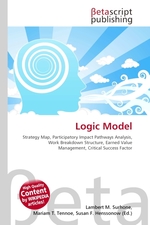Logic Model
Lambert M. Surhone, Miriam T. Timpledon, Susan F. Marseken
бумажная книга
High Quality Content by WIKIPEDIA articles! High Quality Content by WIKIPEDIA articles! A logic model sets out how an intervention (such as a project, a program, or a policy) is understood or intended to produce particular results. Some versions of a logic model present it as four components in a linear sequence: inputs, activities, outputs, and outcomes. These represent the logical flow from: 1. inputs (resources such as money, employees, and equipment) to. 2. work activities, programs or processes, to. 3. the immediate outputs of the work that are delivered to customers, to. 4. outcomes or results that are the long-term consequences of delivering outputs. Other versions of a logic model set out a series of intermediate results, explaining in more detail the logic of how an intervention contributes to intended or observed results.The difference between these two approaches can be illustrated through the example of teacher home visits in Weiss' 1972 evaluation book.
Данное издание не является оригинальным. Книга печатается по технологии принт-он-деманд после получения заказа.


